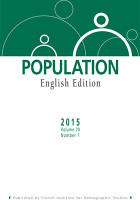
Population 2015, n°1
2015
Cris Beauchemin
- Migration between Africa and Europe (MAFE ): Advantages and Limitations of a Multisite Survey Design
Cris Beauchemin
Sophie Vause et Sorana Toma
- What Drives Onward Mobility within Europe? The Case of Senegalese Migration between France, Italy and Spain
Sorana Toma, Eleonora Castagnone
- Return Migration to Senegal and the Democratic Republic of Congo: Intention and Realization
Marie-Laurence Flahaux
- Does International Migration Lead to Divorce? Ghanaian Couples in Ghana and Abroad
Kim Caarls, Valentina Mazzucato
- Book review
Migration between Africa and Europe (MAFE ): Advantages and Limitations of a Multisite Survey Design
Cris Beauchemin
Paradoxically, while sub-Saharan migration represents only a small fraction of total migrant flows and stocks in Europe, it has become a major topic of public debate. This is perhaps because quantitative data on African migration are quite scarce, so the phenomenon is poorly understood. In response to this knowledge gap, the MAFE project (Migration between Africa and Europe) was set up to collect original quantitative data with the aim of shedding new light on African migration. This article presents the methodology of the MAFE project, whose goal was to produce data for analysis of migration trends, their causes and consequences at micro level. The MAFE project is based on comparable, longitudinal (retrospective), multilevel and multi-topic data concerning three African migration flows (migrants from DR Congo, Ghana and Senegal). A multisite approach is adopted, based on surveys conducted in countries of both origin and destination. Beyond the MAFE project, this article highlights the classic problems encountered by surveys on international migration, and recommends a more (self-)critical approach in this field of research.
Is the Feminization of International Migration Really on the Rise? The Case of Flows from DR Congo and Senegal
Sophie Vause, Sorana Toma
Previous research, mostly focused on Asian and Latin American contexts, found that women are increasingly present in international migration flows, especially as independent economic actors. This article examines the extent to which these two trends can be observed in the African context. It uses data collected as part of the Migration between Africa and Europe (MAFE) project in Senegal, DR Congo and several European countries. Discrete-time event-history analysis reveals only moderate increases in the likelihood of female migration over time, especially towards Western destinations, but no decline in gender gaps. The collection of rich retrospective information from both current and return migrants allows a more in-depth investigation of the nature of women’s moves. Several indicators can be used to examine the extent to which women move autonomously or in association to their partner. While some evidence of a rise in autonomous female migration was found among the Congolese, no salient change was visible in Senegal. The findings were interpreted in light of the more rigid patriarchal system and traditional gender norms that characterize Senegal in comparison to DR Congo.
What Drives Onward Mobility within Europe? The Case of Senegalese Migration between France, Italy and Spain
Sorana Toma, Eleonora Castagnone
Onward mobility – leaving the country of destination in order to move to a third country – is an under-researched phenomenon which challenges the idea that migration is a one-off event, leading to permanent settlement in the country of destination. Taking advantage of a recent multi-sited survey on migration between Senegal and France, Italy and Spain, this article examines the drivers of onward mobility within Europe. The biographic nature of the data enables us to adopt a life-course perspective and to analyse, in a discrete-time event history framework, the ways in which processes of economic, legal and social integration at destination shape subsequent mobility trajectories. Findings show that the low-skilled, the self-employed and the unemployed, as well as those lacking longer-term residence permits are the most likely to re-migrate. Furthermore, the presence of kin and friends in the country of settlement discourages remigration, whereas social ties in other European countries constitute one of the most important resources in triggering onward mobility within Europe.
Return Migration to Senegal and the Democratic Republic of Congo: Intention and Realization
Marie-Laurence Flahaux
Using life event history data collected by the MAFE project survey of migrants in Europe and return migrants in their countries of origin, this article aims to analyse, first, the initial return intentions of Senegalese and Congolese migrants to Europe, and second, the realization of those intentions. The results reveal that at the time of their arrival, individuals who migrate to Europe with the objective of acquiring resources for later use in their country of origin plan to return there. However, if the situation in their country of origin seriously deteriorates, as was the case in the Democratic Republic of Congo from the 1990s onward, migrants tend to plan to remain permanently in Europe. Furthermore, the more difficult it is to migrate to Europe, the less likely migrants are to plan to return. Finally, worsening political and economic conditions in the origin country and restrictive immigration policies in host countries discourage migrants who initially plan to return home from following through on those plans.
Does International Migration Lead to Divorce? Ghanaian Couples in Ghana and Abroad
Kim Caarls, Valentina Mazzucato
This article examines the effects of international migration on the probability of divorce among Ghanaian couples in 2009. Couples that experienced joint migration, and those where the husband and/or the wife migrated alone are compared with couples with no migration experience. The relationship between migration and divorce is contextualized with anthropological insights into marital relationships in Ghana. Ghanaian data from the Migrations between Africa and Europe (MAFE) research programme, containing retrospective information on married couples, are analysed. Discrete-time event history analysis shows that migrant couples have higher divorce rates than non-migrant couples, but only when the wife migrated, either independently or jointly. Couples who spend longer periods apart are also more likely to divorce, especially when it is the husband who migrates.
Prix TTC : 20,00 €

